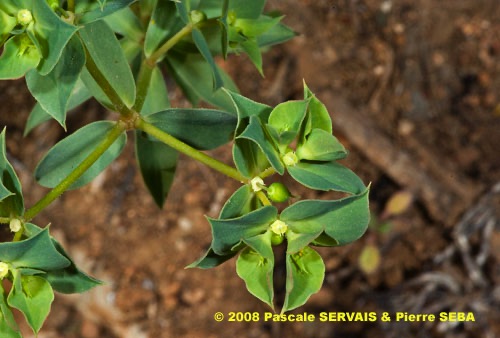
Euphorbia falcata L.
Fam. : Euphorbiaceae
© Pascale SERVAIS & Pierre SEBA, 2018. Tilo Botanica: Flore de Tilos et du Dodécanèse / Flora of Tilos and of the Dodecanese
English translation by Brenda Bradbury, Howard Bradbury and Stéphane Léonard
Plante herbacée, monoïque, à tiges glabres, dressées, simples ou peu ramifiées, libérant un suc laiteux quand on les coupe.
Feuilles alternes, simples, linéaires à lancéolées, parfois spatulées, glabres, glauques, sessiles, souvent couvertes d’une pruine cireuse.
Fleurs à symétrie radiaire, vert jaunâtre, réunies en ombelles à 3 à 6 rayons principaux qui se ramifient jusqu’à 3 ou 4 fois en fourches successives, avec à la base des bractées vertes, triangulaires à ovales. Cyathe composé d’une fleur femelle à ovaire pendant, de plusieurs fleurs mâles et de glandes nectarifères jaunes en forme de croissant à pointes courtes. Ovaire supère.
Fruits, capsules à 3 graines, poilues, en forme de baies, de 3 mm de diamètre, lisses, non côtelées. Graines gris pâle, cannelées.
___________________________
Plant herbaceous, monoecious. Stems glabrous, erect, simple or not very branched, releasing a milky sap when cut.
Leaves alternate, simple, linear to lanceolate, sometimes spatulate, glabrous, glaucous, sessile, often covered in a waxy bloom.
Flowers radially symmetrical, yellowish green, joined together in umbels with 3 to 6 main rays which ramify up to 3 or 4 times in successive forks, with green, triangular to ovate bracts at the base. Cyathium made up of a female flower with a hanging ovary, surrounded by several male flowers and yellow nectariferous glands in the shape of a crescent with short points. Ovary superior.
Fruits, hairy capsules with 3 seeds, in the shape of berries, 3 mm in diameter, smooth, nonribbed. Seeds pale grey, grooved.
Descripteurs / Identifying features
1
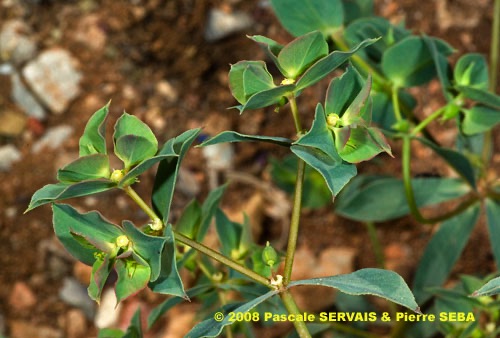
2
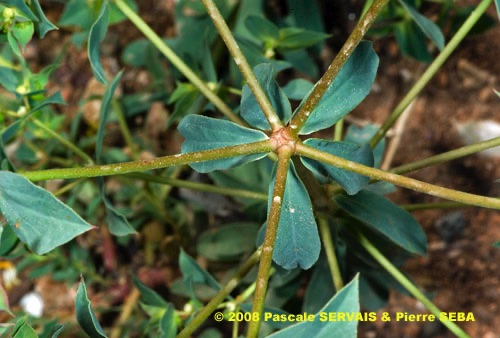
3
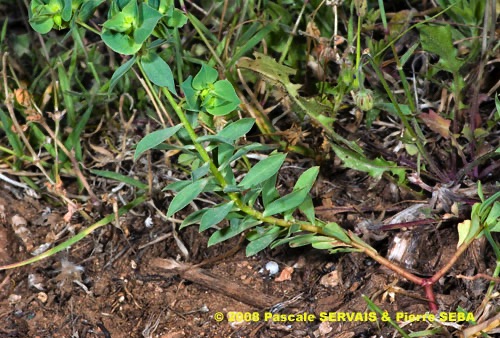
4
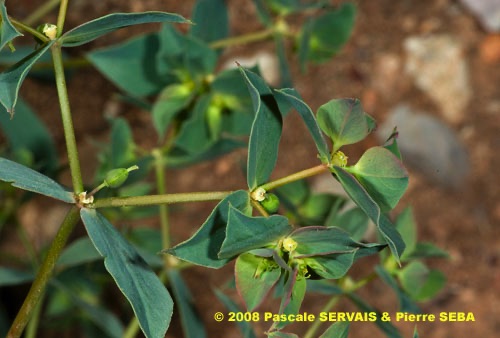
5
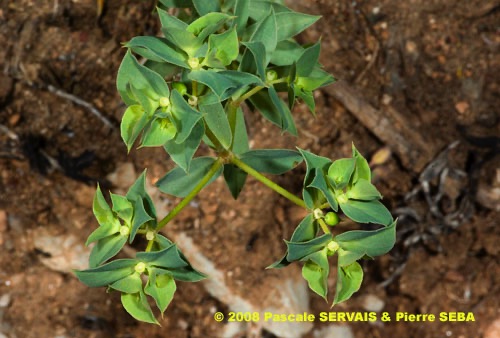
6
Étymologie / Etymology :
Euphorbia : emprunt du latin euphorbia, -ae (nom), nom donné à la
plante par Pline, naturaliste latin mort en 79 apr. J.-C., forme latinisée
du grec ancien εὐφόρβιον, -ου (nom) [ < εὖ (adv.) = bien +
φέρβω (verbe) = nourrir ] = bien nourri, gras, nom donné à la plante
par Dioscoride, médecin et botaniste grec mort en 90 apr. J.-C.
OU
nom donné en l’honneur d’Euphorbe, médecin du roi Juba de
Mauritanie au 1er siècle après J.-C.
Falcata : emprunt du latin falcatus, -a, -um (adj.)
[ < falx, falcis (nom) = la faux ] = en forme de faux, courbé, courbe.
Euphorbia : borrowed from Latin euphorbia, -ae (noun), name given to
the plant by Plinius, Latin naturalist died in 79 AD, Latinized form of
the Classical Greek εὐφόρβιον, -ου (noun) [ < εὖ (adv) = well +
φέρβω (verb) = to feed ] = well fed, fat, name given to the plant by
Dioscorides, Greek doctor and botanist died in 90 AD.
OR
name given in honour of Euphorbos, doctor of king Juba of Mauritania
in the 1st century AD.
Falcata : borrowed from Latin falcatus, -a, -um (adj)
[ < falx, falcis (noun) = scythe ] = sickle-shaped, curved, bent.
Synonymes / Synonyms :
Esula falcata (L.) Haw.
Keraselma falcata (L.) Raf.
Tithymalus falcatus (L.) Klotzsch & Garcke ex Garcke
Noms vernaculaires / Common names :
Noms français / French names :
Euphorbe à cornes en faucille — Euphorbe en faux.
Nom grec / Greek name :
Ευφόρβιες.
Noms anglais / English names :
Sickle spurge — Sickle-leaf spurge.
Noms allemands / German names :
Sichel-Wolfsmilch — Sichelblättrige Wolfsmilch.
Nom espagnol / Spanish name :
Lechetrezna tonta.
Nom italien / Italian name :
Euforbia falcata.
Habitat :
Cultures - Lieux pierreux - Lieux incultes - Lieux humides, mares -
Chemins.
Cultivated places - Stony places - Waste ground - Damp places, ponds -
Waysides.
Île / Island :
Tilos.
Hauteur / Height range :
De 10 cm à 30 cm.
From 10 cm to 30 cm.
Floraison / Flowering time :
De mars à septembre.
From March to September.
Groupe / Classification :
Dicotylédones.
Dicotyledons.
Pérennité / Lifespan :
Annuelle.
Annual.
Description :
Clés dichotomiques et descripteurs distinctifs des 13 espèces / Dichotomous keys and distinctive identifying features of the 13 species
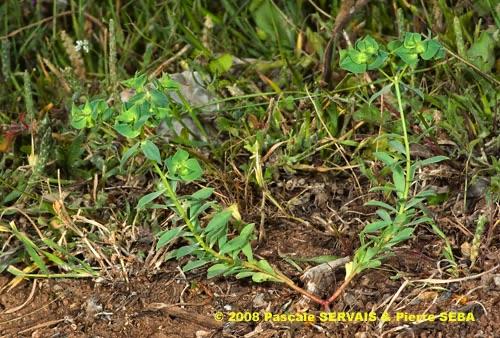
7
Photo 1 :
Localisation / Location : Tilos, Livadia, Village
Date : 20/04/2008
GPS : Lat. 36,41226° N / Long. 27,38521° E / Alt. 7 m
Type : Photographie numérique / Digital Photograph (10 mégapixels)
Photo 2 :
Localisation / Location : Tilos, Livadia, Village
Date : 20/04/2008
GPS : Lat. 36,41226° N / Long. 27,38521° E / Alt. 7 m
Type : Photographie numérique / Digital Photograph (10 mégapixels)
Photo 3 :
Localisation / Location : Tilos, Livadia, Village
Date : 20/04/2008
GPS : Lat. 36,41226° N / Long. 27,38521° E / Alt. 7 m
Type : Photographie numérique / Digital Photograph (10 mégapixels)
Photo 4 :
Localisation / Location : Tilos, Livadia, Village
Date : 20/04/2008
GPS : Lat. 36,41226° N / Long. 27,38521° E / Alt. 7 m
Type : Photographie numérique / Digital Photograph (10 mégapixels)
Photo 5 :
Localisation / Location : Tilos, Livadia, Village
Date : 20/04/2008
GPS : Lat. 36,41226° N / Long. 27,38521° E / Alt. 7 m
Type : Photographie numérique / Digital Photograph (10 mégapixels)
Photo 6 :
Localisation / Location : Tilos, Livadia, Village
Date : 20/04/2008
GPS : Lat. 36,41226° N / Long. 27,38521° E / Alt. 7 m
Type : Photographie numérique / Digital Photograph (10 mégapixels)
Photo 7 :
Localisation / Location : Tilos, Livadia, Village
Date : 20/04/2008
GPS : Lat. 36,41226° N / Long. 27,38521° E / Alt. 7 m
Type : Photographie numérique / Digital Photograph (10 mégapixels)

Google Maps
Google Maps
Google Maps
Google Maps
Google Maps
Google Maps
Google Maps